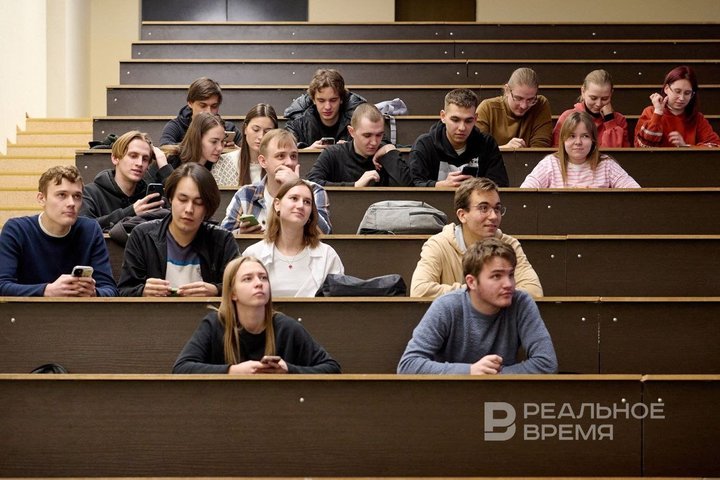Rustem Mukhametzyanov: ‘There has been a decline in Japanese learning recently’
An associate professor of Kazan Federal University on the transition of Kazan students to friendly countries’ languages and the popularity of Korean pop culture

There is still great interest in studying foreign languages in Russia; about 30,000 people are admitted to universities to study these programs every year. However, recently, there has been a shift in choosing new languages and a decline in interest in previously popular languages. Thus, Kazan Federal University (KFU) noted a decrease in applicants wishing to study Japanese, although the popularity of Eastern culture remains high. In an interview with Realnoe Vremya, Rustem Mukhametzyanov, head of the Department of Chinese Studies and Asia-Pacific Research at the Institute of International Relations of KFU, talked more about new trends, students’ requests and the prospects for the cancellation of K-pop in Russia in detail.
Fewer people willing to learn Japanese
Mr Mukhametzyanov, in recent years, Asian pop culture has begun to gain great popularity, especially after the release of the acclaimed TV series The Squid Game, the film Parasite and Liu Cixin’s book The Three-Body Problem. K-pop and anime have a lot of fans. How did this affect the number of people willing to study Oriental languages in Kazan?
There have always been a lot of students in Far Eastern areas: folks came to study Chinese and Korean. The decision to study them may, indeed, be based on one’s passion for Asian pop culture. This can be an impetus for a person to start learning a language. There are folks who once became interested in art and began to study the language in order to understand the lyrics of songs or even films in the original version. In addition, students realise that once they master languages, they can easily find a job.

However, recently, the number of people willing to learn Japanese has decreased. I think this is due to sanctions. At the same time, exchanges between countries continue, but there are fewer students.
Also, don’t forget that being interested in pop culture is one thing, learning a language is another. Asian languages are very complex, their culture is very complex, it requires effort, but it is worth it.
If K-pop should be banned in Russia
Recently, the Russian Foreign Ministry announced a possible response to the ban on Russian culture in South Korea. Someone was worried that K-pop and doramas might be banned in our country. Do you think this is possible?
Yes, of course, anything can be banned. You can even turn off the Internet because after all, K-pop is not shown on Channel One. But what will this give us? For Orientalists, for example, this is sad because we need to hear the sound of the language, and not only the old but also the modern sound. The language lives and develops, youth music is a must for language learners because one can learn slang and feel the evolution of the language through it.

K-pop can be banned, as I already said, but what is the alternative for young people? If alternative options were created for young people, the rest would die on its own. But I, for example, am not a supporter of the artificial creation of underground, so I think that this cannot be created intentionally.
At the same time, perhaps in the next three years, two or three new stars will appear in Russia, after which young people will not need anything at all in the outside world. Then the issue of banning K-pop will automatically disappear.
How the popularity of Asian culture began
At what point did the popularity of Asian culture begin to grow in our country and what is this connected with?
Asian pop culture probably came to Kazan in the 2010s,when popular music and films from Asia appeared on air.
The Tatarstan capital is a paradoxical city in this regard. It seemed like a big city, but it was impossible to find modern books in English, comics or manga in the stores. Before 2010, this simply did not exist in the city, after which paraphernalia of other cultures appeared.
From this moment on, Asian culture began to be popular. People were interested in it before, but it was small groups that had difficulty finding interesting things and exchanging them. The phenomenon became widespread about 14 years ago.
As for cuisine, for example, many Asian cultural establishments have actually opened in Kazan lately. We have a lot of Vietnamese cuisine, Chinese places have started to open often in the last year. Popularity lies in having an option. The younger generation is interested in trying something else.
There was also a “flight to the East” in Europe in the last century. Young people were keen on it. For them, it was an alternative to the picture existing in Europe; they were looking for something new. It's interesting, beautiful, another culture that fascinates. It is different from ours. Perhaps this is a search for something fabulous.

Asia talks about its culture. Its peoples invest quite a lot in talking about their traditions in an understandable language and broadcasting their culture, so it is widely known. We don't have to spend a lot of time to find anime, K-pop, etc. It’s all easy to find.
Soft power works, there is such a concept in international relations when a country openly broadcasts its culture, music, films, thus forming a positive image of the state. This works in Asia, and we see it.
“The Koreans have shamans, the Japanese embody the image of samurai and geisha”
Some people think that Chinese, Korean, Japanese cultures are largely the same, they are often confused. What are the differences and similarities?
These cultures really have a lot in common, and it’s easy for the average person to confuse them. So, the people from these cultures know their past and traditions very well — they do not violate them. For example, insulting the elderly and insubordination are still unacceptable among them, which we can notice in all three cultures. This is a kind of game with historical artefacts. They take an old myth and make new art out of it.
Also, nature is an integral part of their culture. Art and nature are connected — it is part of the space. They don’t oppose themselves to it.
As for the differences, all three cultures are initially located in different historical contexts. Japan is a territory limited in space, hence they have a different perception of the person, the body. The Chinese and Koreans do not have this. Koreans have shamans, modern culture still refers to them.
The specificity of their socio-historical development also plays a role. It also makes a difference. For example, the Japanese embody the image of samurai and geisha, while the Koreans and Chinese have other heroes.
To a greater extent, it was Korea that started this wave of soft power, the broadcast of manners, which was followed by China and Japan. Their cultures are truly fascinating, young people are interested in it, which is why Asian contemporary art remains popular.